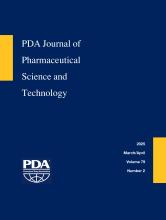Article CommentaryCommentary
Challenges and Solutions to Manufacturing of Low-Viscosity, Ultra-High Concentration IgG1 Drug Products: From Late Downstream Process to Final Fill Finish Processing
Vaibhav Deokar, Alok Sharma and Subrahmanyam M. Volety
PDA Journal of Pharmaceutical Science and Technology March 2025, 79 (2) 218-235; DOI: https://doi.org/10.5731/pdajpst.2023.012873
Vaibhav Deokar
Biotechnology Division, Lupin Limited, Lupin Research Park, 46/47A, Nande Village, Mulshi Taluka, Pune 412115, Maharashtra, India; and
Alok Sharma
Biotechnology Division, Lupin Limited, Lupin Research Park, 46/47A, Nande Village, Mulshi Taluka, Pune 412115, Maharashtra, India; and
Subrahmanyam M. Volety
Department of Pharmaceutical Biotechnology, Manipal College of Pharmaceutical Sciences, Manipal Academy of Higher Education (Deemed University), Manipal 576104, Karnataka, India

References
- 1.↵Global Monoclonal Antibodies (Mabs) Market Data and Industry Growth Analysis. https://www.thebusinessresearchcompany.com/report/monoclonal-antibodies-global-market-report (accessed January 17, 2023).
- 2.↵Information on approval of new antibody. https://www.antibodysociety.org/ (accessed January 17, 2023).
- 3.↵Information on approval of new antibody. https://www.fda.gov/drugs/development-approval-process-drugs/drug-approvals-and-databases (accessed January 17, 2023).
- 4.↵Information regarding antibody concentration and formulation composition for newly approved antibody in European Public Assessment Report (EPAR). https://www.ema.europa.eu/en/medicines/human (accessed January 17, 2023).
- 5.↵Information on subcutaneous formulation for Trastuzumab, Herceptin SC. https://www.fda.gov//drugs/drug-approvals-and-databases/fda-approves-new-formulation-herceptin-subcutaneous-use (accessed March 5, 2020).
- 6.↵
- 7.↵
- Drewe E.,
- Powell R. J.
- 8.↵
- Shieu W.,
- Stauch O. B.,
- Maa Y.-F.
- 9.↵
- 10.↵
- Shieu W.,
- Lamar D.,
- Stauch O. B.,
- Maa Y.-F.
- 11.↵
- Wang S. S.,
- Yan Y.,
- Ho K.
- 12.↵
- 13.↵
- Holstein M.,
- Hung J.,
- Feroz H.,
- Ranjan S.,
- Du C.,
- Ghose S.,
- Li Z. J.
- 14.↵
- 15.↵
- 16.↵
- Hanslip S.,
- Desai K. G.,
- Palmer M.,
- Kemp I.,
- Bell S.,
- Schofield P.,
- Varma P.,
- Roche F.,
- Colandene J. D.,
- Nesta D. P.
- 17.↵
- 18.↵
- Kollár É.,
- Balázs B.,
- Tari T.,
- Siró I.
- 19.↵
- Johnson B.,
- Rostovtsev A.
- 20.↵SIELC, Inc. New Mixed-Mode HILIC - Advances in Retention Control and Selectivity, September 2007 Newsletter. https://www.sielc.com/wp-content/uploads/2015/11/SIELC_September_2007.pdf (accessed December 19, 2019).
- 21.↵
- Bhandare P.,
- Madhavan P.,
- Rao B. M.,
- Rao N. S.
- 22.↵
- 23.↵
- Shire S. J.
- 24.↵
- Appelblad P.,
- Jonsson T.,
- Pontén E.,
- Jiang W.
- 25.↵
- 26.↵
- 27.↵
- Maa Y,
- Nguyen P.
- 28.↵
- Sonner C.,
- Maa Y.-F.,
- Lee G.
- 29.↵
- 30.↵
- 31.↵Merck Millipore Filtration Guide for Durapore filter. Durapore® Membrane Filters - Filter Discs and Membranes. merckmillipore.com (accessed January 17, 2023).
- 32.↵
- Siew A.
- 33.↵
- 34.↵International Organization for Standardization. ISO 11040-8:2016 Prefilled syringes — Part 8: Requirements and Test Methods for Finished Prefilled Syringes. https://www.iso.org/standard/66036.html (accessed March 1, 2020).
- 35.↵
- 36.↵
- 37.
- Das N.
- 38.
- Berteau C.,
- Filipe-Santos O.,
- Wang T.,
- Rojas H.,
- Granger C.,
- Schwarzenbach F.
- 39.
- 40.
- 41.
- 42.
- Gikanga B.,
- Turok R.,
- Hui A.,
- Bowen M.,
- Stauch O. B.,
- Maa Y.-F.
- 43.
In This Issue
PDA Journal of Pharmaceutical Science and Technology
Vol. 79, Issue 2
March/April 2025
Challenges and Solutions to Manufacturing of Low-Viscosity, Ultra-High Concentration IgG1 Drug Products: From Late Downstream Process to Final Fill Finish Processing
Vaibhav Deokar, Alok Sharma, Subrahmanyam M. Volety
PDA Journal of Pharmaceutical Science and Technology Mar 2025, 79 (2) 218-235; DOI: 10.5731/pdajpst.2023.012873
Challenges and Solutions to Manufacturing of Low-Viscosity, Ultra-High Concentration IgG1 Drug Products: From Late Downstream Process to Final Fill Finish Processing
Vaibhav Deokar, Alok Sharma, Subrahmanyam M. Volety
PDA Journal of Pharmaceutical Science and Technology Mar 2025, 79 (2) 218-235; DOI: 10.5731/pdajpst.2023.012873
Jump to section
Related Articles
- No related articles found.
Cited By...
- No citing articles found.





